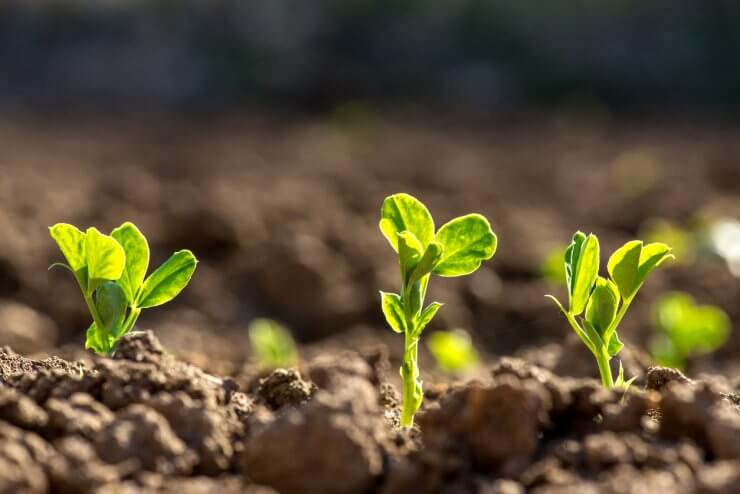
Peas in open land.
When first planning your pea plant garden, you should consider the type of land you can tend. If you have a large outside plot of land with the right soil and the right conditions for watering and draining, you might have the ideal situation for planting directly in the ground. If, however, your soil is too heavy or not the right composition, you might want to consider planting in raised beds or in containers or pots. Converting your open-land plot into a usable garden might involve a lot of time and effort better spent considering raised beds or containers.
Pea Planting Tip: Before planting, soak your pea seeds overnight in lukewarm water. The next day, drain them and sprinkle a nitrogen-fixing inoculant (Rhizobium leguminosarum) over them just before planting. This will cause the legumes to form the nitrogen fixing nodules that boost production in pea plants for higher yields.
Growing in Raised Beds
Creating raised beds for your pea plant has a lot of advantages. One is that the soil within the raised bed will warm up faster than the ground. Another is that you can control drainage better in raised beds, making it more likely your pea seeds and seedlings will survive. Raised beds also work well in conjunction with cold frames, making a sweet spot for your peas to grow.
It can be a lot of work the first time you set up your beds, but you’ll discover that watering, irrigation, weeding, and even harvesting are much easier, with items closer to your reach and contained in a space that is more manageable than growing in open land. And once you create your raised beds the first time, subsequent years will be easier.
To create nicely contained raised beds for your peas, enclose your raised beds with wooden sides at least eight inches tall—this will help keep the bed together, be tall enough, and make irrigation easier, too. With raised beds, your garden is less likely to contain the seeds of weeds that are often found in garden soil. You’ll minimize the incidence of weeds overall, which will save you time and effort later. Weeding itself is much easier with raised beds, because you don’t have to get down so far on the ground to remove weeds.
Annual Tip: To optimize the soil in your raised beds, be sure to amend your soil with composting at least once a year—otherwise, your soil can become less productive for your plants.
Growing Peas in Containers or Pots
If you don’t have the space for growing in open land or in raised beds—let’s say you live in an apartment with no land of your own for a garden, for example—you can grow peas in containers or pots on your balcony, porch, patio, or deck.
One great advantage to container gardening is the ability to move plants around more easily to maximize their exposure to the sun.
Tip: If you have trouble moving pots around, because they’re too heavy or too bulky, try putting your pots on slightly raised rolling casters so you can more easily move them around your space.
The potted patio pea plant is not uncommon—you won’t get the same yield as garden grown plants, but you’ll enjoy all the great taste and nutrition. You’ll also need to attend to container-grown pea plants a little differently. You have to be more vigilant about watering and irrigation as plants can dry out much faster and your peas can be more prone to rot. Plus, containers can lose important soil nutrients throughout the season, so you might need additional fertilizer.
You can grow any type of pea plant in a container, so long as you provide a support for the vines to grow on, such as bamboo poles or stakes set into the center of the pot. But bush-type pea plants, which grow shorter than high-climbing varieties, work best.
New container soil provides the best start for your container-grown peas. Use a 5-gallon container with drainage holes and fill it with basic gardening soil. Add a few tablespoons of your favorite fertilizer and you’re ready to plant. Space the pea seeds 2 inches (5 centimeters) apart and 1 inch (2.5 centimeters) beneath the soil. Start your pea plants in a lightly shaded area and move to full-sun exposure once they’ve germinated, nine to 13 days after planting.
What to do with your container soil at the end of the season: At the end of your pea-growing season, the soil in your pots will be spent, which means starting over when you create next year’s garden. Dispose of the soil at the end of the season by dumping the soil somewhere else—in another part of your yard or a place where you won’t be growing plants again.
How do you grow your peas—in open land, in raised beds, or in containers? Why do you prefer your method? Please tell us your tips and tricks for creating perfect pea garden.


 Previous
Previous


What is this and where can we find it? Is there a common name? Rhizobium